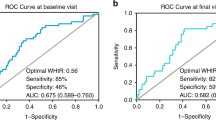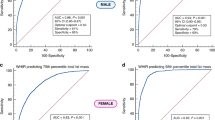Abstract
OBJECTIVE: The aim of this study was to identify in a group of 8-y-old prepubertal children the anthropometric parameter with the highest prediction power of overweight, measured 4 y later.
SUBJECTS: One-hundred and twelve Caucasian children (54 males, 58 females), aged 8.7±0.9 y, were studied.
RESULTS: An analysis of the association between relative body mass index (BMI) at follow-up (%) and some indexes of adiposity like relative BMI (%), waist circumference, subscapular and triceps skinfolds, the sum of four skinfolds and percentage fat mass measured at baseline, showed that relative BMI (relBMI) at baseline had the highest association with relBMI at follow-up (r=0.77; P<0.001); waist circumference had a slightly lower significant association with relBMI at follow-up (r=0.74; P<0.001). In a multiple regression analysis, waist circumference (adjusted for age) accounted for ∼64% of the variation of relBMI at follow-up (P<0.001). RelBMI measured at baseline accounted for ∼59% of the variation of relBMI at follow-up (P<0.001). Multiple logistic regression analysis included waist circumference, adjusted for age, mother's BMI and relBMI measured at baseline as independent variables in the final equation. In particular, each centimeter increase of waist circumference at the age of 8 y doubled the risk of having a relBMI greater than 120% at the age of 12 y.
CONCLUSION: The results of this study, the first which has approached this investigation in children, showed that waist circumference measured at the age of 8 y, which is simple to perform and easy to reproduce, may be a promising index to assess adiposity as well as to predict overweight at puberty.
This is a preview of subscription content, access via your institution
Access options
Subscribe to this journal
Receive 12 print issues and online access
$259.00 per year
only $21.58 per issue
Buy this article
- Purchase on Springer Link
- Instant access to full article PDF
Prices may be subject to local taxes which are calculated during checkout

Similar content being viewed by others

References
WHO . Obesity: preventing and managing the global epidemic Report of a WHO Consultation on Obesity, Geneva, 3–5 June 1997 World Health Organization: Geneva 1998 33–35.
Maffeis C, Schutz Y, Piccoli R et al. Prevalence of obesity in children in north-east Italy Int J Obes Relat Metab Disord 1993 17: 287–294.
Troiano RP, Flegal KM . Overweight children and adolescents: description, epidemiology and demographics Pediatrics 1998 101: 497–504.
Livingstone MBE . Epidemiology of childhood obesity in Europe Eur J Pediat 2000 159 (Suppl 1): S14–S34.
Serdula MK, Ivery D, Coates RJ et al. Do obese children become obese adults? A review of the literature Prev Med 1993 22: 167–177.
Dietz WH . Health consequences of obesity in youth: childhood predictors of adult disease Pediatrics 1998 101: 518–525.
Must A, Jacques PF, Dallal GE et al. Long term morbidity and mortality of overweight adolescents: a follow-up of the Harvard Growth Study of 1922 to 1935 New Engl J Med 1992 327: 1350–1355.
Friedman MA, Brownell KD . Psychological correlates of obesity: moving to the next research generation Psychol Bull 1995 117: 3–20.
Quesenberry CP, Caan B, Jacobson A . Obesity, health service use, and health care cost among members of a Health Maintenance Organization Arch Intern Med 1998 158: 466–472.
Wolf AA, Colditz GA . Current estimates of the economic cost of obesity in the United States Obes Res 1998 6: 97–106.
Wadden TA . The management of obesity: from past failure to future attainment In: Guy-Grand B, Ailhaud G (eds). Progress in obesity research: 8 John Libbey: New York 1999 713–719.
Whitaker RC, Wright JA, Pepe MS et al. Predicting obesity in young adulthood from childhood and parental obesity New Engl J Med 1997 337: 869–873.
Dietz WH, Bellizzi MC . Introduction: the use of body mass index to assess obesity in children Am J Clin Nutr 1999 70 (Suppl): 123S–125S.
Ellis KJ, Abrams SA, Wong WW . Monitoring childhood obesity: assessment of the weight/height2 index Am J Epidemiol 1999 150: 939–946.
Franklin MF . Comparison of weight and height relations in boys from 4 countries Am J Clin Nutr 1999 70 (Suppl): 157S–162S.
Wang J, Thornton JC, Russell M et al. Asians have lower body mass index (BMI) but higher percent body fat than do whites: comparison of anthropometric measurements Am J Clin Nutr 1994 60: 23–28.
Stunkard AJ, Albaum JM . The accuracy of self-reported weight Am J Clin Nutr 1981 34: 1953–1959.
Tanner JM . Growth at adolescence 2nd edn. Blackwell: Oxford 1962.
Rolland-Cacherà MF, Sempè M, Guillaud-Bataille M et al. Adiposity indices in children Am J Clin Nutr 1982 36: 178–184.
Lohman TG . Applicability of body composition techniques and constants for children and youth Exerc Sport Sci Rev 1986 14: 325–357.
Goran MI, Driscoll P, Jhonson R et al. Cross-calibration of body-composition techniques against dual-energy X-ray absorptometry in young children Am J Clin Nutr 1996 63: 299–305.
Gutin B, Litaker M, Islam S et al. Body-composition measurement in 9–11-year-old children by dual-energy X-ray absorptiometry, skinfold thickness measurements, and bioimpedance analysis Am J Clin Nutr 1996 63: 287–292.
Pietrobelli A, Faith M, Allison DB et al. Body mass index as a measure of adiposity among children and adolescents: a validation study J Pediatr 1998 132: 204–210.
Marks GC, Habicht JP, Mueller WH . Reliability, dependability, and precision of anthropometric measurements. The Second National Health and Nutrition Examination Survey 1976–1980 Am J Epidemiol 1989 130: 578–587.
Daniels SR, Khoury PR, Morrison JA . The utility of body mass index as a measure of body fatness in children and adolescents: differences by race and gender Pediatrics 1997 99: 804–807.
Mueller WH, Kaplowitz HJ . The precision of anthropometric assessment of body fat distribution in children Ann Hum Biol 1994 21: 267–274.
Goran MI, Gower BA . Relation between visceral fat and disease risk in children and adolescents Am J Clin Nutr 1999 70 (Suppl): 149S–156S.
Pi-Sunyer FX . Health implications of obesity Am J Clin Nutr 1991 53 (Suppl): 1595S–1603S.
Goran MI, Gower BA . Abdominal obesity and cardiovascular risk in children Coron Art Dis 1998 9: 483–487.
Caprio S, Hyman LD, McCarthy S et al. Fat distribution and cardiovascular risk factors in obese adolescent girls: importance of the intraabdominal fat depot Am J Clin Nutr 1996 64: 12–17.
Maffeis C, Pietrobelli A, Grezzani A, Provera S, Tatò L . Waist circumference and cardiovascular risk factors in prepubertal children Obes Res 2001 (in press)
Goran MI, Kaskoun MC, Shuman WP . Intra-abdominal adipose tissue in young children Int J Obes Relat Metab Disord 1995 19: 279–283.
Fox K, Peters D, Armstrong N et al. Abdominal fat deposition in 11-y-old children Int J Obes Relat Metab Disord 1992 16: 443–449.
Lemieux S, Prud'homme D, Bouchard C et al. Sex differences in the relation of visceral adipose tissue accumulation to total body fatness Am J Clin Nutr 1993 58: 463–467.
Freedman DS, Serdula MK, Srinivasan SR, Berenson GS . Relation of circumferences and skinfold thicknesses to lipid and insulin concentrations in children and adolescents: the Bogalusa Heart Study Am J Clin Nutr 1999 69: 308–317.
Taylor RW, Jones IE, Williams SM, Goulding A . Evaluation of waist circumference, waist-to-hip ratio, and the conicity index as screening tools for high trunk fat mass, as measured by dual-energy X-ray absorptiometry, in children aged 3–19 y Am J Clin Nutr 2000 72: 490–495.
Bandini LG, Schoeller DA . Total body fat distribution and glucose tolerance in adolescents Am J Clin Nutr 1986 43: 696.
Freedman DS, Srinivasan SR, Burke GL et al. Relation of body fat distribution to hyperinsulinemia in children and adolescents: the Bogalusa Heart Study Am J Clin Nutr 1987 46: 403–410.
Dwyer JT, Stone EJ, Yang M et al. Predictors of overweight and overfatness in a multiethnic pediatric population. Child and Adolescent Trial for Cardiovascular Health Collaborative Research Group Am J Clin Nutr 1998 67: 602–610.
Acknowledgements
This study was supported by the National Research Council, Rome, Italy, contract no. 96.03441.CT04 and by Nestlè Italiana Spa, Italy.
Author information
Authors and Affiliations
Corresponding author
Rights and permissions
About this article
Cite this article
Maffeis, C., Grezzani, A., Pietrobelli, A. et al. Does waist circumference predict fat gain in children?. Int J Obes 25, 978–983 (2001). https://doi.org/10.1038/sj.ijo.0801641
Received:
Revised:
Accepted:
Published:
Issue Date:
DOI: https://doi.org/10.1038/sj.ijo.0801641
Keywords
This article is cited by
-
Individual fatty acids in erythrocyte membranes are associated with several features of the metabolic syndrome in obese children
European Journal of Nutrition (2019)
-
Alcohol consumption or cigarette smoking and cardiovascular disease risk in youth with type 1 diabetes
Acta Diabetologica (2019)
-
Policaptil Gel Retard® significantly reduces body mass index and hyperinsulinism and may decrease the risk of type 2 diabetes mellitus (T2DM) in obese children and adolescents with family history of obesity and T2DM
Italian Journal of Pediatrics (2015)
-
Methodologies to assess paediatric adiposity
Irish Journal of Medical Science (1971 -) (2015)
-
Validity of parentally reported versus measured weight, length and waist in 7- to 9-year-old children for use in follow-up studies
European Journal of Pediatrics (2014)


